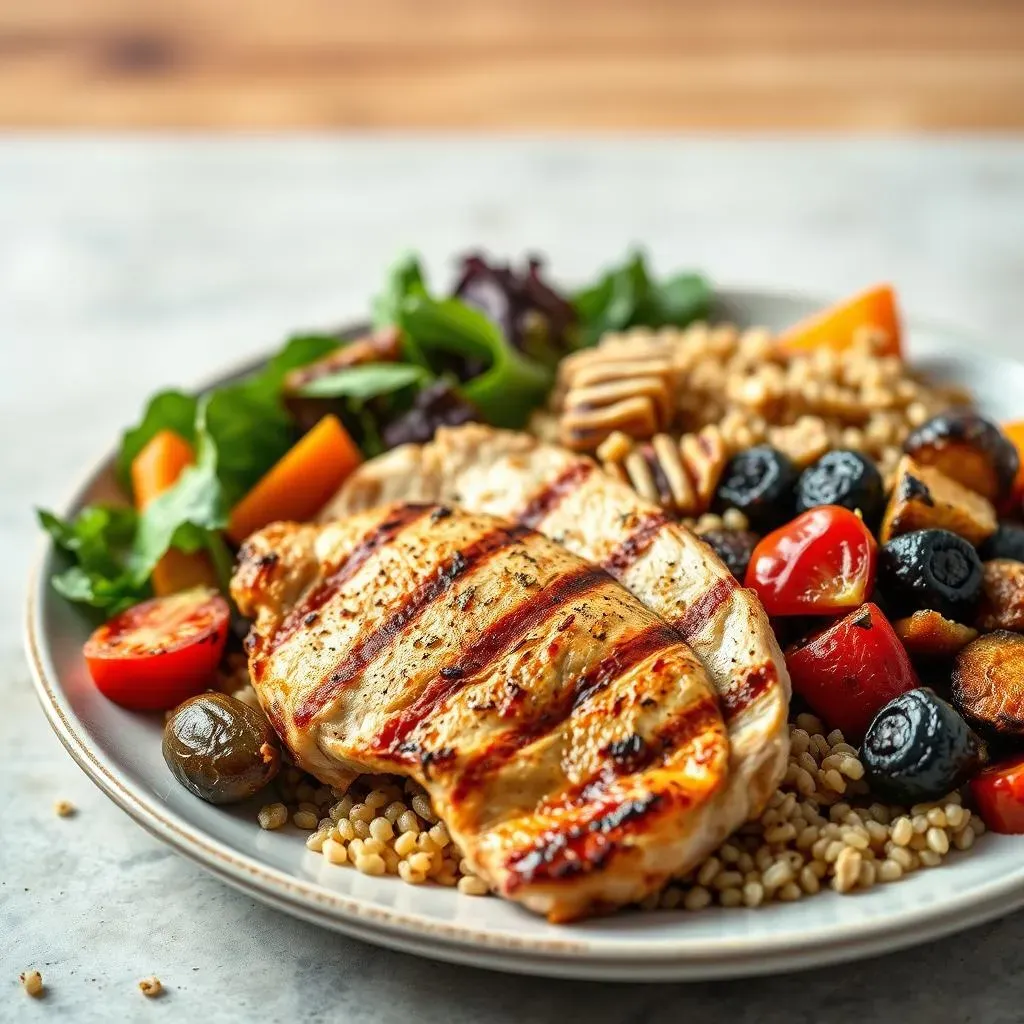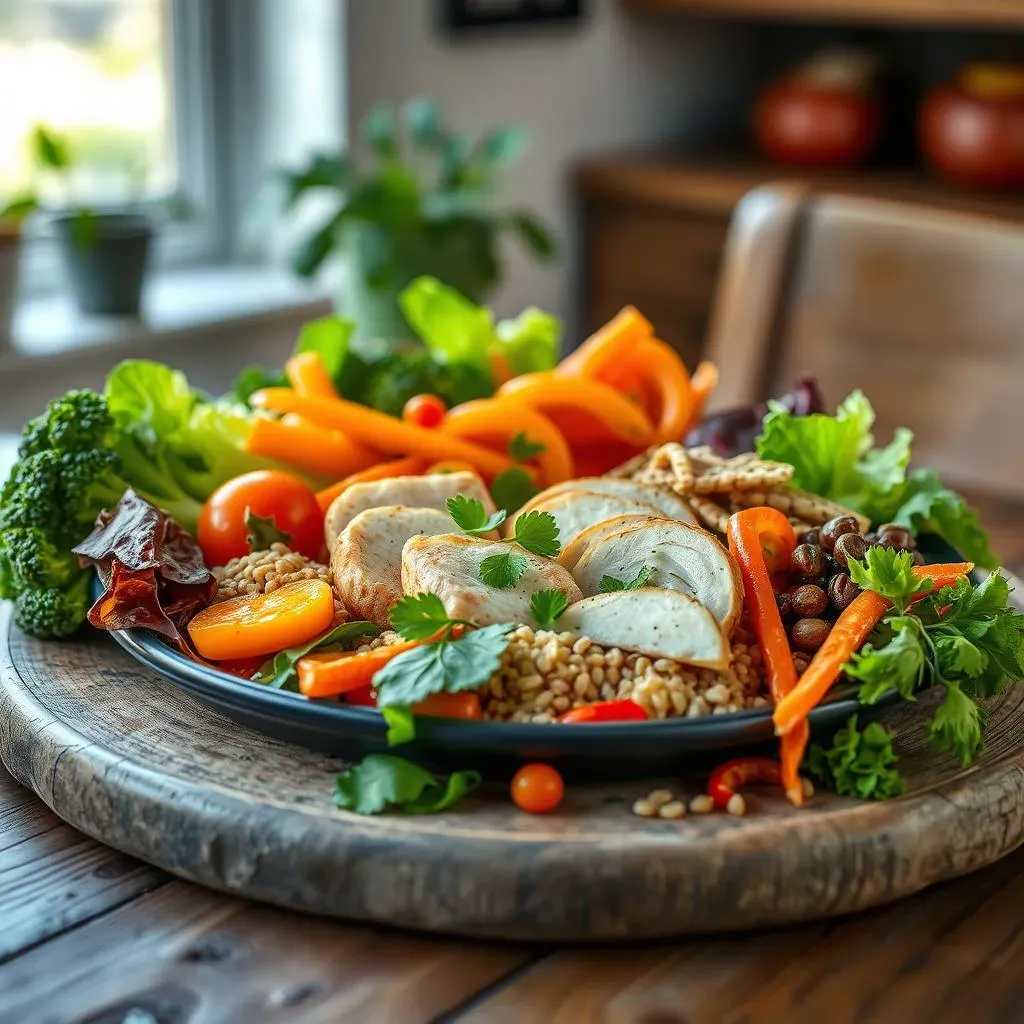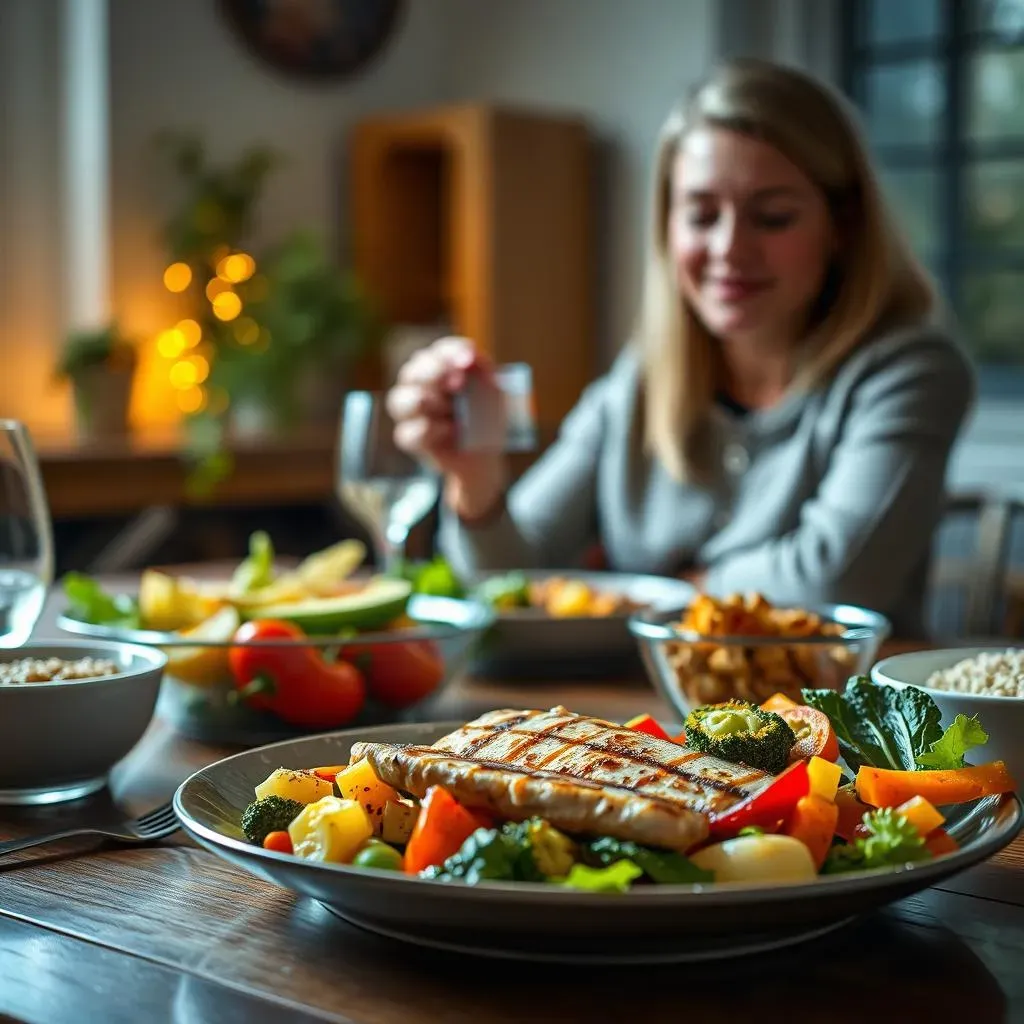Table of Contents
Ever stared into your fridge, wondering, "how many calories is a healthy dinner, anyway?" I get it. It’s a nightly puzzle, trying to balance taste, fullness, and not feeling like you’ve eaten a whole pizza by yourself. We're bombarded with diet advice, making it hard to know what’s actually good for us. This article isn't about strict rules, it's about finding a happy medium. We’ll explore what a sensible calorie range looks like for dinner, ditching the boring diet food for tasty, satisfying meals. We’ll look at how to make low-calorie dinners that actually fill you up, not leave you hunting for snacks an hour later. Plus, we will dive into high-protein, low-calorie options to keep you feeling strong. So, let's figure out this dinner thing together and make every meal a win, not a worry.
What's a Good Calorie Count for a Healthy Dinner?

What's a Good Calorie Count for a Healthy Dinner?
The Calorie Sweet Spot
so you're wondering about the magic number for dinner calories, right? There isn't a single answer, because we're all different. Think of it like finding the right size shoe; it's gotta fit you. Generally, a good range for a healthy dinner is somewhere between 400 and 700 calories. This gives you enough fuel to keep you going, without feeling stuffed or like you are going to sleep right after. If you're super active, you might need a bit more. If you're chilling on the couch most evenings, maybe aim for the lower end.
Don't get too hung up on the exact number, though. It's more about balance. A 450-calorie dinner of a burger and fries isn't the same as a 450-calorie dinner of grilled chicken, veggies, and sweet potato. The quality of the food matters, not just the calorie count. A good rule of thumb: focus on whole foods, lean proteins, and lots of veggies. That way, you get a good mix of nutrients, and you're more likely to feel satisfied.
Activity Level | Approximate Calorie Range |
|---|---|
Lightly Active | 400-500 |
Moderately Active | 500-600 |
Very Active | 600-700+ |
Listen to Your Body
I think the biggest mistake people make is trying to fit into a generic calorie box. Your body is smart, and it gives you clues. Are you feeling hungry an hour after dinner? Then you probably need more food or more protein and fiber. Are you feeling sluggish and heavy? Maybe you ate too much. It's all about listening to those signals. Don't be afraid to adjust your portion sizes based on how you feel.
And seriously, don't stress about it. Life's too short to be counting every single calorie. The goal is to make dinner a healthy and enjoyable part of your day. If you eat well most of the time, the occasional treat won't derail you. It’s all about finding a sustainable approach that works for your lifestyle and makes you feel good.
"The best diet is the one you don't know you're on." - Someone smart, probably.
Low Calorie Dinner Ideas That Don't Skimp on Taste

Low Calorie Dinner Ideas That Don't Skimp on Taste
Flavor Bombs, Not Calorie Bombs
so low-calorie doesn't have to mean bland and boring. I used to think that eating healthy was all about sad salads, but boy was I wrong! It's all about using flavor to make your taste buds happy, without loading up on extra calories. Think about spices, herbs, and zesty sauces. A little chili powder, some fresh cilantro, a squeeze of lime – these can transform a simple dish into something amazing. Don't be shy with garlic and onions either; they add a lot of depth without many calories. Roasting vegetables also brings out their natural sweetness, which is way better than just boiling them!
Another trick? Get creative with your cooking methods. Grilling, baking, and stir-frying with a little bit of oil are all great options that keep things light. And don’t forget about textures! Adding something crunchy, like some toasted nuts or seeds, can make a meal feel more satisfying. It’s all about making each bite interesting, so you don’t feel like you’re missing out. The goal is to create meals that are both light and exciting, so you actually look forward to eating them. Trust me, your tastebuds will thank you.
Easy Peasy Low-Calorie Meals
Let's get real, we don't all have hours to spend in the kitchen. That's why I love quick and easy recipes. A go-to of mine is a big bowl of lentil soup. It's packed with fiber and protein, super filling, and you can throw in any veggies you have on hand. Another winner is sheet pan dinners. Just toss some chicken or fish, with your favorite veggies, and roast it all together. It's minimal effort, minimal cleanup, and maximum flavor. Seriously, it's a lifesaver on busy weeknights.
Don’t be afraid to experiment with different cuisines too. Asian-inspired stir-fries with lots of veggies and a light sauce are fantastic, or try a Mediterranean-style salad with grilled chicken or chickpeas. The key is to focus on fresh, whole ingredients and avoid heavy sauces and dressings. I think a lot of people get intimidated by the idea of "healthy cooking", but it really doesn’t have to be complicated. Start with simple recipes, get comfortable with the basics, and you’ll be surprised how easy it is to make delicious, low-calorie meals.
Low-Calorie Dinner Idea | Key Ingredients | Why It's Great |
|---|---|---|
Lentil Soup | Lentils, veggies, broth | High in fiber and protein, filling |
Sheet Pan Dinner | Chicken/fish, veggies, herbs | Easy, minimal cleanup |
Stir-Fry | Veggies, lean protein, light sauce | Quick, customizable, flavorful |
High Protein, Low Calorie Dinner: The Best of Both Worlds

High Protein, Low Calorie Dinner: The Best of Both Worlds
Why Protein is Your Friend
Let's talk about protein, it's seriously the superstar of weight management. When you're trying to keep your calories in check, protein is your secret weapon. It helps you feel full and satisfied, which means you're less likely to reach for those late-night snacks. Plus, it's essential for building and maintaining muscle mass. Think of it as the building blocks for your body. If you are doing some calisthenics, this is very important for muscle recovery and growth. A good protein intake can help you feel stronger and more energetic, which is a win-win situation.
I think a lot of people focus on cutting calories, but they forget about the importance of protein. It's not just about eating less, it's about eating smarter. When you include protein in your meals, you're not just filling your stomach, you are also giving your body what it needs to stay healthy and strong. It's like giving your car the right kind of fuel. You wouldn't put water in your gas tank, right? It’s the same with your body, you need the right nutrients to function at its best.
Protein-Packed, Low-Calorie Options
so where do you find this magical protein without adding a ton of calories? Lean meats like chicken breast and turkey are excellent choices. Fish, especially white fish and salmon, are also fantastic. They're packed with protein and healthy fats. If you're not a meat-eater, don't worry, there are plenty of plant-based options. Tofu, lentils, chickpeas, and beans are all great sources of protein and fiber. A bowl of lentil soup can be very filling and satisfying, and a tofu stir-fry can be both delicious and nutritious.
I've found that incorporating a variety of protein sources keeps things interesting. It also ensures you're getting a good mix of nutrients. Don’t be afraid to try new things and experiment with different recipes. For example, I’m a big fan of Greek yogurt, it’s loaded with protein and can be used in lots of different ways. You can have it for breakfast, as a snack, or even as a base for sauces and dressings. The key is to be creative and find what works best for you. Remember, healthy eating doesn’t have to be boring!
Protein Source | Calories per Serving | Why it's Great |
|---|---|---|
Chicken Breast | Around 165 (3 oz) | Lean, versatile |
Salmon | Around 200 (3 oz) | Rich in Omega-3s, flavorful |
Lentils | Around 230 (1 cup cooked) | High in fiber, plant-based |
Tofu | Around 80 (3 oz) | Versatile, plant-based |
Balancing Act: Protein and Calories
When you’re aiming for a high-protein, low-calorie dinner, it's all about finding the right balance. You want to include enough protein to keep you full, but you also need to be mindful of your overall calorie intake. One trick is to pair your protein source with lots of low-calorie vegetables. A big salad with grilled chicken or fish is a perfect example. You get a good dose of protein, plus all the vitamins and minerals from the veggies. Another good idea is to use smaller portions of higher-calorie ingredients, like cheese or nuts, to add flavor without going overboard on the calories.
It’s also important to be aware of hidden calories. Sauces and dressings can sometimes pack a lot of calories without adding much to the overall meal. Try using lighter options, like a squeeze of lemon or a drizzle of balsamic vinegar. I’ve learned that it’s all about making smart choices and being mindful of what you’re putting in your body. When you focus on whole, unprocessed foods, you naturally eat healthier and you’ll be surprised how easy it is to create meals that are both delicious and good for you. Remember, it’s a journey, not a race, so be patient with yourself and enjoy the process.
How to Make Sure Your Dinner is a Healthy Amount of Calories

How to Make Sure Your Dinner is a Healthy Amount of Calories
Portion Control is Key
so how do we actually make sure we're not overdoing it at dinner? Portion control is a big one, and I know, it sounds super basic, but honestly, it's a game-changer. I used to pile my plate high, thinking, "I'll just eat until I'm full," which often meant I was way past full. Now I use smaller plates; it's a bit of a mind trick, but it works. When you see a smaller plate filled with food, it looks like a lot, even if it's less than you usually eat. Try measuring out your portions for a few days. You might be surprised at how much you’ve been overeating. It's not about deprivation; it’s about eating a sensible amount that fuels your body without weighing you down.
Another thing I've found helpful is to serve yourself the appropriate portion and then put the rest of the food away immediately, that way you're less tempted to go back for seconds. Don't eat straight from the serving dish or bag. It's easy to keep snacking when the food is right there in front of you. Pay attention to serving sizes on packaging, too. Those numbers are there for a reason, even if they can be a little confusing sometimes. It's all about creating habits that make it easier to manage your portions without even thinking about it too much. You don’t need to be super strict, just mindful.
Tip | How to Implement | Why It Works |
|---|---|---|
Use Smaller Plates | Serve your food on smaller plates or bowls | Makes portions look larger, reduces overeating |
Measure Portions | Use measuring cups and spoons for a few days | Helps you understand correct serving sizes |
Put Food Away | Immediately store leftovers after serving | Reduces temptation for seconds |
Mindful Eating: Savor Every Bite
I think one of the biggest reasons people overeat is because they're not really paying attention to their meal. They're eating in front of the TV, scrolling on their phone, or just wolfing down their food without thinking about it. That’s where mindful eating comes in. It's about slowing down and really savoring each bite. Put down your fork between bites, take a deep breath, and actually taste your food. Notice the flavors, the textures, and the smells. When you eat mindfully, you're more likely to recognize when you're actually full, rather than just eating until you feel stuffed. It's like giving your body a chance to catch up to your stomach.
It's also about listening to your body's hunger cues. Are you really hungry, or are you just bored or stressed? Sometimes we eat for emotional reasons, not because we're actually physically hungry. Before you start eating, ask yourself, "Am I really hungry, or am I just eating out of habit?" If you're not physically hungry, find something else to do. Go for a walk, read a book, or call a friend. It's all about making conscious choices and tuning into what your body needs. I know it sounds a little woo-woo, but it really does make a difference. When you eat with intention, you enjoy your meals so much more, and you're less likely to overeat.
"The food you eat can either be the safest and most powerful form of medicine or the slowest form of poison." - Ann Wigmore
Planning Ahead: The Secret Weapon
so let's talk planning. I know it sounds like a chore, but trust me, it's a total game-changer when it comes to controlling your calorie intake. When you plan your meals ahead of time, you're way less likely to make impulsive, unhealthy choices. It's like having a roadmap for the week, so you’re not just wandering around aimlessly in the kitchen and making bad decisions. I like to spend a little time each weekend thinking about what I’m going to eat for the week, and then I make a grocery list based on that. When you have a plan, it's so much easier to stick to your goals.
Plus, planning your meals allows you to make sure you're getting a balanced diet. You can include plenty of fruits, vegetables, and whole grains, so you're not just filling up on empty calories. And when you have a plan, you're also less likely to get takeout or order pizza at the last minute. I know it can be tempting, but those quick meals are often loaded with extra calories and unhealthy fats. Planning ahead takes a little effort, but it’s worth it. When you know what you're eating, you're in control. It's like being the captain of your own ship, instead of just letting the waves toss you around.
- Plan your meals: Spend some time each week planning your dinners.
- Make a grocery list: Stick to your list when you go shopping.
- Prep ingredients: Chop veggies or cook grains ahead of time.
- Batch cook: Make a large batch of soup or stew to eat throughout the week.
Wrapping Up Your Healthy Dinner Plate
Figuring out "how many calories is healthy dinner" doesn't have to be a constant battle. It's about making smart choices that fit your life, not following strict rules that make you miserable. Remember, a balanced dinner includes protein, veggies, and some healthy fats. Don't be afraid to experiment with different recipes and find what you genuinely enjoy. If you’re aiming for a lower calorie meal, focus on lean proteins and plenty of vegetables. Keep an eye on portion sizes, and don't forget that a little bit of what you fancy is okay too. The goal is to feel good, energized, and satisfied, not deprived. So, go ahead, enjoy your dinner, and make it a part of your healthy lifestyle.